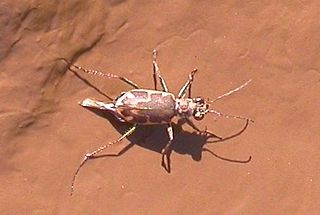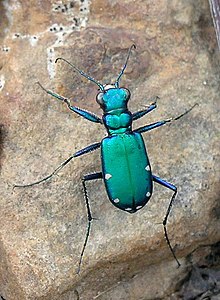
Tiger beetles are a family of beetles, Cicindelidae, known for their aggressive predatory habits and running speed. The fastest known species of tiger beetle, Rivacindela hudsoni, can run at a speed of 9 km/h, or about 125 body lengths per second. As of 2005, about 2,600 species and subspecies were known, with the richest diversity in the Oriental (Indo-Malayan) region, followed by the Neotropics. While historically treated as a subfamily of ground beetles (Carabidae) under the name Cicindelinae, several studies since 2020 indicated that they should be treated as a family, the Cicindelidae, which are a sister group to Carabidae within the Adephaga.

Histeridae is a family of beetles commonly known as clown beetles or hister beetles. This very diverse group of beetles contains 3,900 species found worldwide. They can be easily identified by their shortened elytra that leaves two of the seven tergites exposed, and their geniculate (elbowed) antennae with clubbed ends. These predatory feeders are most active at night and will fake death if they feel threatened. This family of beetles will occupy almost any kind of niche throughout the world. Hister beetles have proved useful during forensic investigations to help in time of death estimation. Also, certain species are used in the control of livestock pests that infest dung and to control houseflies. Because they are predacious and will even eat other hister beetles, they must be isolated when collected.

Dermestidae are a family of Coleoptera that are commonly referred to as skin beetles. Other common names include larder beetle, hide or leather beetles, carpet beetles, and khapra beetles. There are over 1,800 species described.

Libellula quadrimaculata, known in Europe as the four-spotted chaser and in North America as the four-spotted skimmer, is a dragonfly of the family Libellulidae found widely throughout Europe, Asia, and North America.

The Salt Creek tiger beetle is a critically endangered subspecies of tiger beetle endemic to the saline wetlands of northern Lancaster County, Nebraska, adjacent to and immediately to the north of the city of Lincoln, Nebraska. It is a predatory insect, using its mandibles to catch other insects. The beetle is one of the rarest insects in North America; surveys showed that 194 adults existed in 2009, down from 263 in 2008, and 777 in 2000. However, efforts are continuing to boost the population, which in 2013 numbered 365 beetles: one beetle for each day in a regular year. The adult beetles can move very fast to catch the prey.

Pelidnota punctata, the grapevine beetle, spotted June beetle or spotted pelidnota, is a species of beetle in the family Scarabaeidae, subfamily Rutelinae. Grapevine beetles are common in the north and central United States and eastern Canada, but do relatively little damage to their host plants. The beetles fly at a fast speed, usually in a curving flight.

Neocicindela tuberculata is a species of tiger beetle in the family Cicindelidae, endemic to New Zealand. Its common names include common tiger beetle, moeone, and papapa, and in its larval stage penny doctor, butcher boy, kapuku, kui, kurikuri, moeone, and muremure. Neocicindela tuberculata was the first carabid beetle described from New Zealand. The species can run as fast as 5 miles per hour and are considered to be the fastest running beetles. Adult species prefer clay banks in summer and are good predators when in comes to insects.

Cicindela ohlone, the Ohlone tiger beetle, is endemic to California. It was discovered in 1987 and named and described in 1993. C. ohlone is most closely related to Cicindela purpurea.

The ebony jewelwing is a species of broad-winged damselfly. One of about 150 species of Calopterygidae, it is found in the eastern U.S. and southeastern Canada, ranging west to the Great Plains. Other common names include black-winged damselfly.

Cicindela campestris, commonly called the green tiger beetle, is a widespread Eurasian species of tiger beetle. It is the type species of the large genus Cicindela.

Cicindela repanda, commonly known as the bronzed tiger beetle or common shore tiger beetle, is a species of tiger beetle that is 10–13 millimetres (0.39–0.51 in) long and lives in most of North America. It has a small labrum with one tooth and a coppery, hairy pronotum. The shoulder marking usually touches the middle band. It is most often seen in spring and summer, and it lives in sand, gravel, or clay soil. It feeds on many species of insects and even some fruit. The species has a two-year life cycle. It can be found across sand dunes around the Great Lakes. The species comprises three subspecies: C. repanda repanda, C. repanda novascotiae, and C. repanda tanneri.

Thermonectus marmoratus is a relatively colorful North American species of diving beetle known by the common names sunburst diving beetle and yellow-spotted diving beetle. The behavior of this diving beetle has been compared to a scuba diver, since it carries with it a bubble of air as it dives down into the water. Its aquatic larval stage was the first ever recorded use of bifocals in the animal world. The beetle uses in its principal eyes two retinas and two distinct focal planes that are substantially separated, in the manner of bifocals to switch their vision from up-close to distance, for easy and efficient capture of their prey.

Cicindela albissima, commonly called the Coral Pink Sand Dunes tiger beetle is a species of tiger beetle endemic to Coral Pink Sand Dunes State Park in southern Utah, United States. It was originally described by Rumpp in 1962 as the subspecies Cicindela limbata albissima, but mitochondrial DNA, along with the species' morphological and geographical distinctiveness, have shown that it is a separate species. C. albissima can be distinguished from other Cicindela species by its restricted range and lack of pigmentation on its elytra.
Cicindela denikei, Laurentian tiger beetle is a species of tiger beetle in the Cicindelinae subfamily that can be found in Minnesota, Manitoba, and Ontario. The species have green coloured elytron and is 13–15 millimetres (0.51–0.59 in) long. It can be found in gravel and sand as well as coniferous forests where it preys on other insect species. When it comes to hunting, adults are either wait for their prey in an ambush or chase it. It larvae usually digs burrows in which they wait for their victim to come by. Once an unsuspected arthropod is in sight, it opens it jaws and eats it.

Cicindela patruela, the northern barrens tiger beetle, is a species of tiger beetle found in eastern North America. Due to their specific habitat requirements as well as human involvement, populations of this species have declined significantly in several regions, including most of New England, Ontario, and Quebec.

Habroscelimorpha dorsalis, commonly known as the eastern beach tiger beetle, is a species of flashy tiger beetle in the family Cicindelidae. It is found in Central America and North America.

Ellipsoptera puritana, the puritan tiger beetle, is a species of flashy tiger beetle in the family Cicindelidae. It is found in North America. Puritan tiger beetles are found in sandy beaches and rocky cliffs along rivers in Massachusetts, Maryland, and Connecticut. Little is known about this species due to its small geographic range and quickly disappearing populations.

Cicindela tranquebarica, the Oblique-lined tiger beetle, is a species of flashy tiger beetle in the family Cicindelidae that is found in North America. It appears in various colors, but it is most commonly known for its compound eyes. The beetle can range from 11 mm to 16 mm, and females are often observed to be slightly longer than males. This beetle is sensitive to temperature changes and performs stilting to help with temperature regulation. They typically display a variety of social behaviors and are a strong flier.

Habroscelimorpha dorsalis dorsalis, commonly known as the northeastern beach tiger beetle, is the largest subspecies of eastern beach tiger beetle. In 2012, Cicindela dorsalis dorsalis was reclassified under the name Habroscelimorpha dorsalis dorsalis, but the names are used synonymously in recently published literature. Fitting to its common name, the northeastern beach tiger beetle dwells along the U.S. northeast coast in small sand burrows. The beetle is diurnal and can be spotted by its light tan coloring with dark lines and green hues on its thorax and head.

Rivacindela hudsoni is an Australian species of the family Cicindelinae or "tiger beetle" and is the fastest running insect. The genus Rivacindela is contentiously treated as a subgenus of the broader Cicindela and are typically found in salty habitats such as dry salt lakes and salt streams. The species was discovered in South Australia and described in 1997, with an adult form of approximately 20–21mm in length and a running speed of 2.49m/s, or 120 body lengths per second.






















